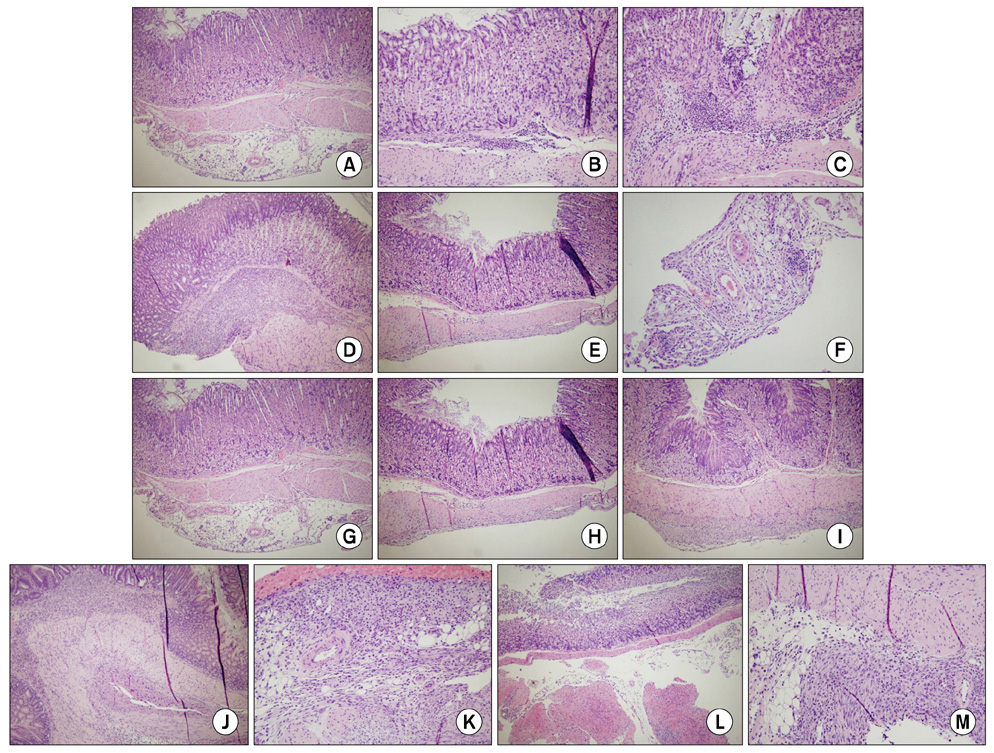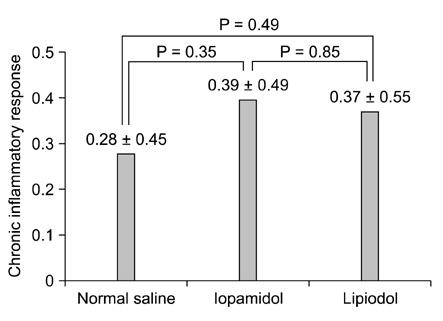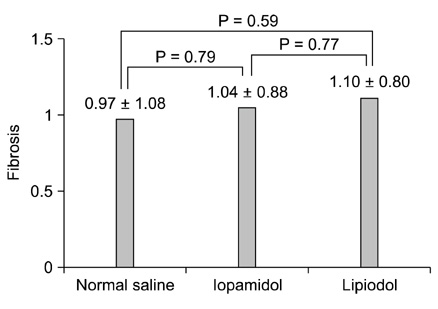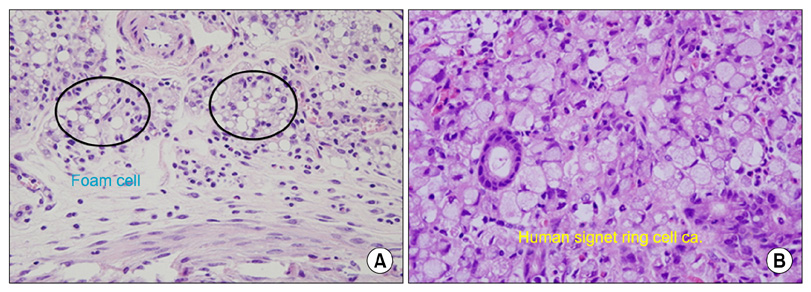J Korean Surg Soc.
2012 Feb;82(2):70-78. 10.4174/jkss.2012.82.2.70.
Local tissue reaction after injection of contrast media on gastric wall of mouse: experimental study for application of contrast media to computed tomography lymphography
- Affiliations
-
- 1Department of Surgery, Pusan National University Yangsan Hospital, Research Institute for Convergence of Biomedical Science and Technology, Yangsan, Korea. hhkim@snubh.org
- 2Department of Surgery, Seoul National University College of Medicine, Seoul, Korea.
- 3Department of Surgery, Seoul National University Bundang Hospital, Seongnam, Korea.
- 4Department of Surgery, Dankook University Hospital, Cheonan, Korea.
- 5Department of Radiology, Seoul National University Bundang Hospital, Seoul National University College of Medicine, Korea.
- 6Department of Pathology, Seoul National University Bundang Hospital, Seongnam, Korea.
- KMID: 2212204
- DOI: http://doi.org/10.4174/jkss.2012.82.2.70
Abstract
- PURPOSE
Computed tomography (CT) lymphography is a simple technique of sentinel node navigation but tissue reaction after injection of contrast media has not been reported yet.
METHODS
Ninety mice used in this study were divided into three groups: lipiodol, iopamidol, and normal saline. The test compounds were given by submucosal injection to the gastric wall of anesthetized mice. The specimens were subjected to histopathological examination.
RESULTS
The mean grades of acute inflammatory response after iopamidol and lipiodol injection were significantly higher than control group. However, there was no significant difference between iopamidol and lipiodol injection. The mean grade of chronic inflammatory response and fibrosis showed no differences between groups. The presence or absence of fibrinoid necrosis and mesothelial hyperplasia showed no statistical differences at each time point between groups. The foam cell, which is similar to human signet ring cell carcinoma, were not identified in normal saline and iopamidol group, but were detected by postoperative day 7 in lipiodol group.
CONCLUSION
We conclude that iopamidol and lipiodol when used as a contrast media of CT lymphography is an available material for preoperative sentinel node navigation surgery for gastric cancer with an acceptable incidence of pathological alterations in a mouse model. Our results are potentially useful to clinical (human) application.
Keyword
MeSH Terms
Figure
Reference
-
1. Cabanas RM. An approach for the treatment of penile carcinoma. Cancer. 1977. 39:456–466.2. Giuliano AE, Jones RC, Brennan M, Statman R. Sentinel lymphadenectomy in breast cancer. J Clin Oncol. 1997. 15:2345–2350.3. Veronesi U, Paganelli G, Galimberti V, Viale G, Zurrida S, Bedoni M, et al. Sentinel-node biopsy to avoid axillary dissection in breast cancer with clinically negative lymphnodes. Lancet. 1997. 349:1864–1867.4. Bass SS, Cox CE, Ku NN, Berman C, Reintgen DS. The role of sentinel lymph node biopsy in breast cancer. J Am Coll Surg. 1999. 189:183–194.5. Kitagawa Y, Kitajima M. Gastrointestinal cancer and sentinel node navigation surgery. J Surg Oncol. 2002. 79:188–193.6. Schwartz GF, Giuliano AE, Veronesi U. Consensus Conference Committee. Proceedings of the consensus conference on the role of sentinel lymph node biopsy in carcinoma of the breast, April 19-22, 2001, Philadelphia, Pennsylvania. Cancer. 2002. 94:2542–2551.7. Morton DL, Wen DR, Wong JH, Economou JS, Cagle LA, Storm FK, et al. Technical details of intraoperative lymphatic mapping for early stage melanoma. Arch Surg. 1992. 127:392–399.8. Borgstein PJ, Pijpers R, Comans EF, van Diest PJ, Boom RP, Meijer S. Sentinel lymph node biopsy in breast cancer: guidelines and pitfalls of lymphoscintigraphy and gamma probe detection. J Am Coll Surg. 1998. 186:275–283.9. Kitagawa Y, Fujii H, Mukai M, Kubota T, Otani Y, Kitajima M. Radio-guided sentinel node detection for gastric cancer. Br J Surg. 2002. 89:604–608.10. Méndez J, Wallace AM, Hoh CK, Vera DR. Detection of gastric and colonic sentinel nodes through endoscopic administration of 99mTc-DTPA-mannosyl-dextran in pigs. J Nucl Med. 2003. 44:1677–1681.11. Yasuda S, Shimada H, Chino O, Tanaka H, Kenmochi T, Takechi M, et al. Sentinel lymph node detection with Tc-99m tin colloids in patients with esophagogastric cancer. Jpn J Clin Oncol. 2003. 33:68–72.12. Moghimi SM, Bonnemain B. Subcutaneous and intravenous delivery of diagnostic agents to the lymphatic system: applications in lymphoscintigraphy and indirect lymphography. Adv Drug Deliv Rev. 1999. 37:295–312.13. Wisner ER, Katzberg RW, Koblik PD, McGahan JP, Griffey SM, Drake CM, et al. Indirect computed tomography lymphography of subdiaphragmatic lymph nodes using iodinated nanoparticles in normal dogs. Acad Radiol. 1995. 2:405–412.14. Hayashi H, Tangoku A, Suga K, Shimizu K, Ueda K, Yoshino S, et al. CT lymphography-navigated sentinel lymph node biopsy in patients with superficial esophageal cancer. Surgery. 2006. 139:224–235.15. Ueda K, Suga K, Kaneda Y, Li TS, Ueda K, Hamano K. Preoperative imaging of the lung sentinel lymphatic basin with computed tomographic lymphography: a preliminary study. Ann Thorac Surg. 2004. 77:1033–1037.16. Kumar V. Kumar V, Abbas AK, Fausto N, Robbins SL, Cotran RS, editors. Acute and chronic inflammation. Robbins and Cotran pathologic basis of disease. 2005. 7th ed. Philadelphia: Elsevier Saunders;47–86.17. Adachi Y, Shiraishi N, Kitano S. Modern treatment of early gastric cancer: review of the Japanese experience. Dig Surg. 2002. 19:333–339.18. Borie F, Millat B, Fingerhut A, Hay JM, Fagniez PL, De Saxce B. Lymphatic involvement in early gastric cancer: prevalence and prognosis in France. Arch Surg. 2000. 135:1218–1223.19. Roviello F, Rossi S, Marrelli D, Pedrazzani C, Corso G, Vindigni C, et al. Number of lymph node metastases and its prognostic significance in early gastric cancer: a multicenter Italian study. J Surg Oncol. 2006. 94:275–280.20. Hayes N, Karat D, Scott DJ, Raimes SA, Griffin SM. Radical lymphadenectomy in the management of early gastric cancer. Br J Surg. 1996. 83:1421–1423.21. Yonemura Y, Wu CC, Fukushima N, Honda I, Bandou E, Kawamura T, et al. Operative morbidity and mortality after D2 and D4 extended dissection for advanced gastric cancer: a prospective randomized trial conducted by Asian surgeons. Hepatogastroenterology. 2006. 53:389–394.22. Smith JW, Shiu MH, Kelsey L, Brennan MF. Morbidity of radical lymphadenectomy in the curative resection of gastric carcinoma. Arch Surg. 1991. 126:1469–1473.23. Ohgami M, Otani Y, Kumai K, Kubota T, Kim YI, Kitajima M. Curative laparoscopic surgery for early gastric cancer: five years experience. World J Surg. 1999. 23:187–192.24. Nakahara T, Kitagawa Y, Yakeuchi H, Fujii H, Suzuki T, Mukai M, et al. Preoperative lymphoscintigraphy for detection of sentinel lymph node in patients with gastric cancer--initial experience. Ann Surg Oncol. 2008. 15:1447–1453.25. Kitagawa Y, Saha S, Kubo A, Kitajima M. Sentinel node for gastrointestinal malignancies. Surg Oncol Clin N Am. 2007. 16:71–80.26. Yuasa Y, Seike J, Yoshida T, Takechi H, Yamai H, Yamamoto Y, et al. Sentinel lymph node biopsy using intraoperative indocyanine green fluorescence imaging navigated with preoperative CT lymphography for superficial esophageal cancer. Ann Surg Oncol. 2011. 07. 27. [Epub]. DOI: 10.1245/s10434-011-1922-x.27. Tangoku A, Seike J, Nakano K, Nagao T, Honda J, Yoshida T, et al. Current status of sentinel lymph node navigation surgery in breast and gastrointestinal tract. J Med Invest. 2007. 54:1–18.28. Suga K, Shimizu K, Kawakami Y, Tangoku A, Zaki M, Matsunaga N, et al. Lymphatic drainage from esophagogastric tract: feasibility of endoscopic CT lymphography for direct visualization of pathways. Radiology. 2005. 237:952–960.29. Songun I, Bonenkamp JJ, Hermans J, van Krieken JH, van de Velde CJ. Prognostic value of resection-line involvement in patients undergoing curative resections for gastric cancer. Eur J Cancer. 1996. 32A:433–437.30. Kakeji Y, Tsujitani S, Baba H, Moriguchi S, Mori M, Maehara Y, et al. Clinicopathologic features and prognostic significance of duodenal invasion in patients with distal gastric carcinoma. Cancer. 1991. 68:380–384.31. Papachristou DN, Agnanti N, D'Agostino H, Fortner JG. Histologically positive esophageal margin in the surgical treatment of gastric cancer. Am J Surg. 1980. 139:711–713.
- Full Text Links
- Actions
-
Cited
- CITED
-
- Close
- Share
- Similar articles
-
- Lymphography with Ultrasound Contrast Media
- An experimental study on tissue damage following subcutaneous injection of water soluble contrast media
- Preparative fasting before contrast-enhanced computed tomography
- MR Application of Contrast Media in Focal Liver Diseases
- An experimental study on radiological examination of obstructed small bowel with various contrast media







